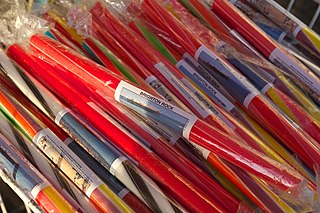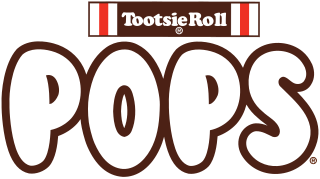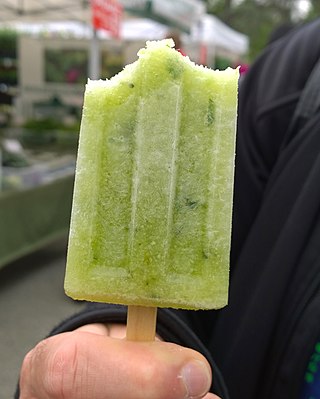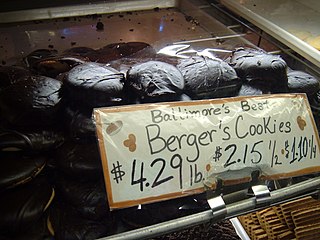Related Research Articles

Mentha is a genus of plants in the family Lamiaceae. The exact distinction between species is unclear; it is estimated that 13 to 24 species exist. Hybridization occurs naturally where some species' ranges overlap. Many hybrids and cultivars are known.

Confectionery is the art of making confections, which are food items that are rich in sugar and carbohydrates. Exact definitions are difficult. In general, however, confectionery is divided into two broad and somewhat overlapping categories: bakers' confections and sugar confections. The occupation of confectioner encompasses the categories of cooking performed by both the French patissier and the confiseur.

Rock is a type of hard stick-shaped boiled sugar confectionery most usually flavoured with peppermint or spearmint. It is commonly sold at tourist resorts in the United Kingdom and Ireland ; in Gibraltar; in Denmark in towns such as Løkken and Ebeltoft; and in Sydney and Tasmania, Australia.

A candy cane is a cane-shaped stick candy often associated with Christmastide, as well as Saint Nicholas Day. It is traditionally white with red stripes and flavored with peppermint, but the canes also come in a variety of other flavors and colors.

Mentos are a brand of packaged scotch mints or mint-flavored candies sold in stores and vending machines. First produced in 1932, they are currently sold in more than 130 countries worldwide by the Italian-Dutch corporation Perfetti Van Melle. The mints are small oblate spheroids, with a slightly hard exterior and a soft, chewy interior.

Life Savers is an American brand of ring-shaped hard and soft candy. Its range of mints and fruit-flavored candies is known for its distinctive packaging, coming in paper-wrapped aluminum foil rolls.

A garnish is an item or substance used as a decoration or embellishment accompanying a prepared food dish or drink. In many cases, it may give added or contrasting flavor. Some garnishes are selected mainly to augment the visual impact of the plate, while others are selected specifically for the flavor they may impart. This is in contrast to a condiment, a prepared sauce added to another food item primarily for its flavor. A food item which is served with garnish may be described as being garni, the French term for "garnished."

A Tootsie Pop is a hard candy lollipop filled with the chocolate-flavored chewy Tootsie Roll candy. They were invented in 1931 by an employee of The Sweets Company of America. Tootsie Rolls had themselves been invented in 1896 by Leo Hirschfield. The company changed its name to Tootsie Roll Industries in 1969. The candy made its debut in 1931 and since then various flavors have been introduced. The idea came to be when a man who worked at The Sweets Company of America licked his daughter's lollipop at the same time he was chewing his Tootsie Roll. He loved the idea and pitched it to everyone at the next snack ideas meeting.

Barley sugar is a traditional variety of boiled sweet, often yellow or orange in colour, which is usually made with an extract of barley, giving it a characteristic taste and colour. In Britain it is usually sold in the shape of twisted sticks. Barley sugar is very similar to clear toy candy and to hard caramel candy in its texture and taste.
Bobs Candies are a brand of candy manufactured by the Ferrara Candy Company.
Fruit-tella are chewy sweets similar to Sugus, Starburst and Chewits. They are made using real fruit juice, natural colours and natural flavours, sugar and gelatine. They are made by Perfetti Van Melle, the company that also manufactures Mentos and Chupa Chups.

An ice pop is a liquid/cream-based frozen dessert on a stick. Unlike ice cream or sorbet, which are whipped while freezing to prevent ice crystal formation, an ice pop is frozen while at rest, becoming a solid block of ice. The stick is used as a handle to hold it. Without a stick, the frozen product would be a freezie.

The city of Baltimore, Maryland, has been a predominantly working-class town through much of its history with several surrounding affluent suburbs and, being found in a Mid-Atlantic state but south of the Mason-Dixon line, can lay claim to a blend of Northern and Southern American traditions.
Li'l Missy Beaded Doll Kits were made in the early 1970s. The 6" tall doll had a dylite form body that required no sewing. Each kits included pins, sequins, beads, colorful fabric, ribbons and trim. Other embellishments included flowers and fruit. There was a large variety of kits representing countries of the world, careers, holidays, birthdays, etc. These kits were a big hit with girls from ages 8 to 75. Additional accessories available were revolving plastic musical stands, plastic display domes and cardboard doll houses, some sold in a three doll package.

Berger Cookies are a handmade cookie made and marketed by DeBaufre Bakeries of Baltimore, Maryland. The cookies are widely known for their thick, chocolate frosting on an imperfectly shaped shortbread cookie. Not unlike a black and white cookie, the Berger Cookie is frosted on its flat bottom, giving the final cookie an overall rounded shape. Each weighs 1.25 ounces, with the cake-like under-cookie weighing a quarter of an ounce, and the chocolate/fudge frosting weighing an ounce. DeBaufre distributes packaged Berger Cookies via a delivery network around Baltimore and markets the cookies worldwide via internet sales.

Sherbet is a fizzy, sweet powder, usually eaten by dipping a lollipop or liquorice, using a small spoon, or licking it from a finger.

Stick candy is a long, cylindrical variety of hard candy, usually four to seven inches in length and 1/4 to 1/2 inch in diameter, but in some extraordinary cases up to 14 inches in length and two inches in diameter. Like candy canes, they usually have at least two different colors swirled together in a spiral pattern, resembling a barber's pole.
The Flower Mart is an annual festival native to the neighborhood of Mount Vernon in Baltimore, Maryland. The Flower Mart is held each year at the beginning of May. Participants and vendors at the Flower Mart offer gardening tips, sell plants and seedlings, and other gardening-related goods. Along with vendors are various forms of live entertainment and edible treats for guests, such as its traditional lemon sticks. The Flower Mart has produced many annual traditions.
References
- ↑ Up-to-date Candy Teacher Archived 2014-04-08 at the Wayback Machine Page 65 Charles Apell 1921
- ↑ Rigby's Reliable Candy Teacher: With Complete and Modern Soda, Ice Cream and Sherbet Sections, Will O. Rigby, Fred Rigby, Rigby Publishing Company, 1920
- ↑ The Philadelphia story about lemon sticks May 3, 2012 The Baltimore Sun
- 1 2 Gorelick, Richard (May 3, 2013). "Consider the lemon stick: The FlowerMart treat has become a Baltimore treasure". The Baltimore Sun . Archived from the original on April 20, 2014. Retrieved April 20, 2014.
- ↑ Gorelick, Richard (May 3, 2013). "Consider the lemon stick: The FlowerMart treat has become a Baltimore treasure". The Baltimore Sun. Archived from the original on April 20, 2014. Retrieved April 20, 2014.
- ↑ "Blast from the Past, Lemon Peppermint Stick". Jillian's Kitchen. May 6, 2011. Archived from the original on 4 March 2016. Retrieved 14 April 2015.